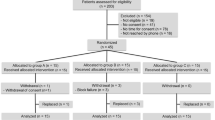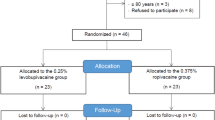Abstract
Objective: The aim of this investigation was to compare the clinical effects and pharmacokinetics of lidocaine and prilocaine in two groups of 15 patients undergoing axillary brachial plexus anaesthesia.
Methods: The study had a randomised design. Patients were allocated to one of the two groups of 15. Each group received either lidocaine (600mg = 2.56 mmol/L + 5 mg/L adrenaline) or prilocaine (600mg = 2.72 mmol/L + 5 mg/L adrenaline), injected over a period of 30 seconds. Onset of the surgical analgesia was defined as the period from the end of the injection of the local anaesthetic to the loss of pinprick sensation in the distribution of all three nerves.
Results: The mean onset time of surgical analgesia of both lidocaine and prilocaine was 10 minutes. Lidocaine was biexponentially eliminated with a rapid elimination phase half-life (t½α) of 9.95 ± 14.3 minutes and a terminal elimination phase half-life (t½β) of 2.86 ± 1.55 hours. Lidocaine was metabolised to MEGX (monoethylglycylxylidide); time to reach maximum plasma concentration (tmax) 2.3 ± 0.8 hours; maximum plasma concentration (Cmax) 0.32 ± 0.13 mg/L; t½β 2.4 ± 2.4 hours. Lidocaine total body clearance was 67.8 ± 28.8 L/h. Prilocaine was rapidly and biexponentially eliminated with a t½α of 9.4 ± 18.4 minutes and a t½β of 2.12 ± 1.28 hours. The total body clearance of prilocaine (150 ± 53 L/h) was higher than that of lidocaine (p = 0.0255). Both compounds demonstrated a comparable volume of distribution (Vd), while the volume of distribution at steady-state (Vss) and the volume of distribution in the second compartment (Vβ) values of prilocaine were a factor of 1.6 higher than those of lidocaine (p < 0.001). Both compounds showed a comparable t½α (p > 0.8) and a comparable t½β (p = 0.26).
Conclusion: Following axillary administration, lidocaine and prilocaine demonstrated similar pharmacokinetic behaviour and could therefore be used as the clinical preference for this regional anaesthesia technique.
Similar content being viewed by others
References
Bier A. Über einen neuen Weg Lokalanästhesie an den Gliedmaassen zu erzeugen. Archiv Klinische Chirurgie 1908; 86: 1007–16
Hirscheil G. Die anästhessierung des plexus brachialis bei Operationen an der oberen extremität. Munch Med Wochenschr 1911; 58: 1555–6
Pearce H, Lindsay D, Leslie K. Axillary brachial plexus block in two hundred consecutive patients. Anaesth Intensive Care 1996; 24: 453–8
Winnie AP. Perivascular techniques of brachial plexus block. In: Håkannson L, editor. Plexus Anesthesia. Vol. I. Denmark Schultz/Churchill Livingstone, 1984; 121–44
Bartholomew K, Sloan JP. Prilocaine for Bier’s block: how safe is safe? Arch Emerg Med 1990; 7: 189–95
Wildsmith JAW. Prilocaine. An under-utilized local anesthetic. Reg Anesth 1985; 10: 155–9
Aantaa R, Kirvelä O, Lahdenperä A, et al. Transarterial brachial plexus anesthesia for hand surgery: a retrospective analysis of 346 cases. J Clin Anesth 1994; 6: 289–92
Büttner J, Klose R, Dreesen H. Vergleichende Untersuchung von Prilocain 1% und Mepivacain 1% zur axillären Plexusanaesthesie. Reg Anesth 1987; 10: 70–5
McEllistrem RF, O’Malley K, O’Toole D, et al. Interscalene brachial plexus blockade with lidocaine in chronic renal failure — a pharmacokinetic study. Can J Anaesth 1989; 36: 59–63
Schüle H. Klinisch-experimentelle Untersuchungen über die Verkehrstüchtigkeit nach zahnärztlichen Eingriffen. Dtsch Zahn Zeitung 1980; 35: 183–9
Wörner H, Frank S, Stumpf H. Lokalanästhesie und Verkehrstüchtigkeit. Dtsch Zahn Zeitung 1980; 35: 377–84
Hollmén A. Axillary plexus block. Acta Anaesthesiol Scand 1966; 10Suppl. XXI: 53–6
Lindberg RLP, Pilhlajmaki KK. High-performance liquid Chromatographic determination of bupivacaine in human serum. J Chromatogr 1988; 360: 369–74
Proost JH, Meijer DKW. MW/Pharm, an integrated software package for drug dosage regimen calculation and therapeutic drug monitoring. Comput Biol Med 1992; 22: 155–63
Pitkänen MT, Suzuki N, Rosenberg PH. Intravenous regional anaesthesia with 0.5% prilocaine or 0.5% chloroprocaine. A double blind comparison in volunteers. Anaesthesia 1992; 47: 618–9
Borchard U, Niesel HC. Grundlagen der Pharmakologie der Lokalanästhetika. In: Niesel HC, editor. Regionalanästhesie Lokalanästhesie Regionale Schmerztherapie. Stuttgart: Georg Thieme, 1994: 35–68
Niesel HC. Klinische Pharmakologie und Toxikologie. Anwendung der Lokalanästhetika. In: Niesel HC, editor. Regionalanästhesie Lokalanästhesie Regionale Schmerztherapie. Stuttgart: Georg Thieme, 1994: 69–165
Solak M, Akturk G, Erciyes N, et al. The addition of sodium bicarbonate to prilocaine solution during i.v. regional anaesthesia. Acta Anaesth Scand 1991; 35: 572–4
Adams JP, Dealy EJ, Kenmore PI. Intravenous regional anesthesia in hand surgery. J Bone Joint Surg 1964; 46A: 811–6
Eerola R. A comparative study of carticaine and prilocaine in regional intravenous analgesia. Prakt Anaesth 1974; 9: 171–5
Sorbie C, Chacha P. Regional anaesthesia by the intravenous route. BMJ 1965; 1: 957–60
Eriksson E. Prilocaine, an experimental study in man of a new local anaesthetic with special regards to efficacy, toxicity and excretion. Acta Chir Scand Suppl. 1966; 358: 10–24
McCoy EP, Wilson CM. A comparison of lignocaine with prilocaine in axillary brachial plexus anaesthesia. Anaesthesia 1991; 46: 309–11
Hargrove RL, Hoyle JR, Parker JBR, et al. Blood lignocaine levels following intravenous regional analgesia. Anaesthesia 1966; 21: 37–41
Merrifield AJ, Carter SJ. Intravenous regional analgesia: lignocaine blood levels. Anaesthesia 1965; 20: 287–303
Deacock ARC, Simpson WT. Fatal reactions to lignocaine. Anaesthesia 1964; 19: 217–21
Covino BG. Pharmacokinetics of local anaesthetic drugs: In: Prys-Robert C, Hug CG, editors. Pharmacokinetics of anaesthesia. Oxford: Blackwell sci Publishers, 1984: 270–92
Pieper JA, Rodman JH. Lidocaine. In: Evans WE, Schentag JJ, Jusko WJ, Harrison H, editors. Applied pharmacokinetics. Principles of therapeutic monitoring. 2nd ed. Spokane USA; Applied Therapeutics Inc., 1986: 639–81
Arthur GR, Covino BG. Pharmacokinetics of local anaesthetics. In: White PF, editor. Baillière’s Clin Anaesthesiol 1991; Vol 5 (3): 635–58
Hollunger G. On the metabolism of lidocaine. The biotransformation of lidocaine. Acta Pharmacol Toxicol 1960; 17: 365–73
Boyes RN. A review of the metabolism of amide local anaesthetic agents. Br J Anaesth 1975; 47: 225–30
Tam YK, Tawfik SR, Ke J, et al. High-performance liquid chromatography of lidocaine and nine of its metabolites in human plasma and urine. J Chromatogr 1987; 423: 199–206
Tucker GT, Mather LE. Clinical pharmacokinetics of local anaesthetics. Clin Pharmacokinet 1979; 4: 241–78
Simon MAM, Gielen MJM, Vree TB, et al. Disposition of lignocaine for intravenous regional anaesthesia during day-case surgery. Eur J Anaesth 1998; 15: 32–7
Akerman B, Aström A, Ross S, et al. Studies on absorption, distribution and metabolism of labelled prilocaine and lidocaine in some animals. Acta Pharmacol Toxicol 1966; 24: 389–403
Geddes IC. Studies of the metabolism of Citanest C14. Acta Aaesth Scand 1965; 2Suppl. XVI: 37–44
Helm M, Holmdahl MH. Biochemical effects of aromatic amines. Cyanosis, methaemoglobinaemia, Heinz-body formation induced by a local anaesthetic agent (prilocaine). Acta Anaesth Scand 1965; 2: 99–120
Tucker GT, Mather LE, Lennard MS, et al. Plasma concentrations of the stereoisomers of prilocaine after administration of the racemate; implications for toxicity? Br J Anaesth 1990; 65: 333–6
Author information
Authors and Affiliations
Corresponding author
Rights and permissions
About this article
Cite this article
Simon, M.A.M., Vree, T.B., Gielen, M.J.M. et al. Comparison of the Effects and Disposition Kinetics of Lidocaine and (±)Prilocaine in Patients Undergoing Axillary Brachial Plexus Block During Day Case Surgery. Clin. Drug Investig. 16, 241–250 (1998). https://doi.org/10.2165/00044011-199816030-00008
Published:
Issue Date:
DOI: https://doi.org/10.2165/00044011-199816030-00008




